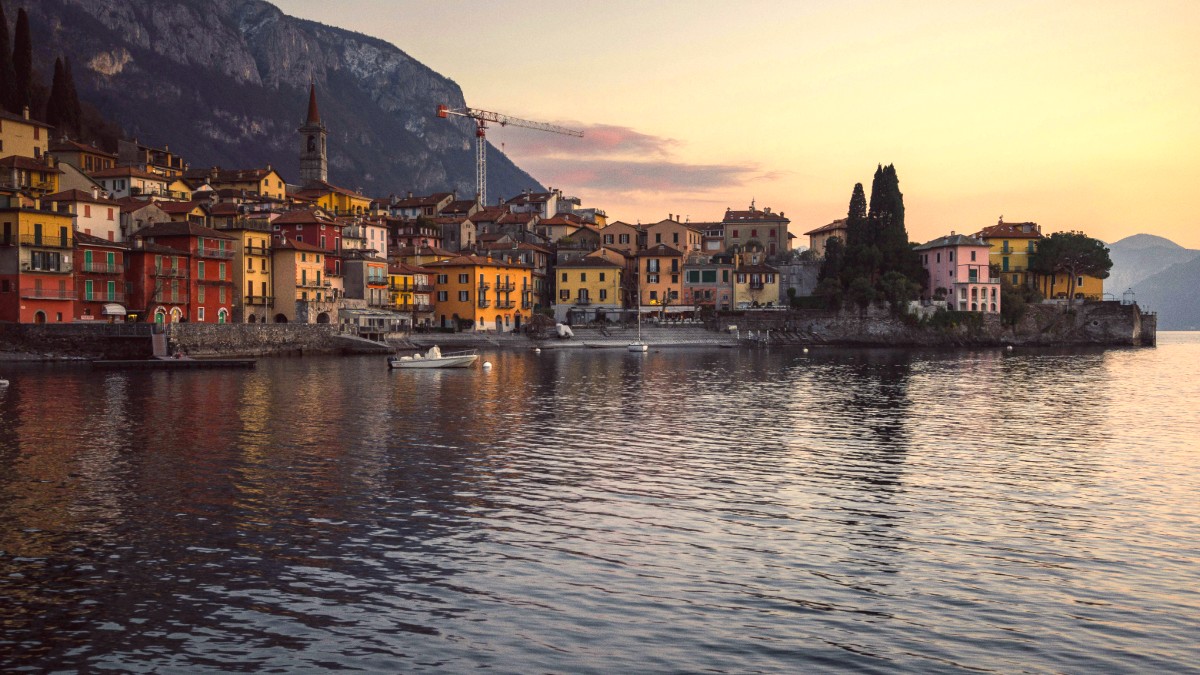
The Italian Lakes, Italy
Freshwater fish like Lavarello, Missoltini (dried shad), and perch are common, often fried or grilled. Polenta, a staple cornmeal dish, arrives soft, grilled, or mixed with cheese and butter. Rice appears extensively in risottos. Local cheeses like Gorgonzola, Taleggio, and Grana Padano feature prominently. Butter frequently enriches many preparations. Game meats, like wild boar, venison, and rabbit, appear on menus, especially in autumn and winter, reflecting hunting traditions.
The cuisine often uses butter as a cooking fat, a distinction from the olive oil-centric cooking of Southern Italy, resulting in richer, heartier dishes.
Lunch (Pranzo) typically takes place from 12:30 PM to 2:30 PM. Dinner (Cena) usually begins from 7:30 PM to 10:00 PM, often later in summer. Many restaurants close between lunch and dinner service. Aperitivo, a popular pre-dinner tradition, allows enjoyment of drinks with complimentary snacks (olives, nuts, small sandwiches) from around 6:00 PM to 8:00 PM. This sometimes serves as a light meal.
A traditional Italian meal presents multiple courses: Antipasto (Appetizer), Primo (First course like pasta, risotto, soup), Secondo (Second course of meat or fish), Contorno (Side dish), Dolce (Dessert), Caffè (Espresso), and Digestivo (After-dinner liqueur). One does not need to order all courses; ordering a primo and a secondo, or just a pizza, is common.
Service charges might appear as "coperto" (cover charge) or "servizio" (service charge) on the bill. If a service charge is included, additional tipping is not strictly necessary but appreciated for exceptional service, usually by rounding up the bill or leaving a few extra euros.
A creamy risotto made with fried freshwater perch fillets, often served simply with butter and sage. This is a signature Lake Como specialty.
Fresh from the lake.
A rich, traditional dish of soft polenta mixed with generous amounts of butter, garlic, and local cheeses (often Casera or Gorgonzola). It delivers a comforting, hearty meal.
Comfort food perfected.
Air-dried, salted beef, thinly sliced, typically presented as an antipasto with rocket (arugula) and Parmesan cheese. This specialty hails from the Valtellina region.
A savory, regional delight.
Explore red wines from the nearby Valtellina region, like Sassella or Sforzato. These pair well with hearty regional dishes.
Franciacorta: A high-quality sparkling wine from Lombardy, often compared to Champagne. Grappa: A common digestivo (after-dinner drink), a strong alcoholic beverage made from grape pomace.
Many luxury hotels and standalone restaurants present high-end dining, often with refined menus, extensive wine lists, and stunning lake views. Reservations are usually suggested.
Trattorias offer a casual atmosphere with traditional, homemade regional fare. Ristoranti are generally more formal than trattorias, with broader menu choices. Osterias are often simpler, focusing on wine and traditional dishes.
Pizzerias offer affordable and delicious pizza, either sit-down or "pizza al taglio" (pizza by the slice). Paninotecas (sandwich shops) provide quick and fresh options. Bars serve breakfast pastries and coffee, often quick lunches (panini, tramezzini).
While less common than in larger cosmopolitan cities, most restaurants can offer vegetarian pasta dishes, vegetable sides (contorni), or pizza without meat or fish. Many pasta dishes are naturally vegetarian.
Communicate your preferences clearly.
Awareness of celiac disease ("celiachia") is growing in Italy. Look for "senza glutine" (gluten-free) options on menus, especially at pizzerias and some restaurants. Inform staff clearly about any allergies (e.g., "allergia a..." for allergy to...). Larger supermarkets often stock gluten-free products.
Websites and apps like HappyCow may point to suitable restaurants.
Learn regional cuisine and techniques.
Explore markets and local producers.
Visit olive oil producers or cheese farms.
Savor local Lombard and Valtellina wines.
Many restaurants present dining with spectacular lake views, crafting a memorable ambiance. Look for establishments with outdoor terraces overlooking the water.
A perfect setting for special occasions.
Some villas and hotels feature beautiful garden restaurants, providing a tranquil and picturesque dining experience amidst lush greenery.
An ideal choice for a serene meal.
Dining in Italy marks a social experience. Service may feel slower than in some countries, reflecting a relaxed pace rather than inattention. Embrace the moment and savor the meal.
Italians typically drink cappuccino only in the morning. After lunch or dinner, order an espresso. Coffee is often enjoyed standing at the bar for a quick moment.
Opportunities exist to visit local olive oil producers, notably in areas like Lenno, celebrated for its mild microclimate conducive to olive growing.
Some cheese farms in the surrounding hills may welcome visitors, offering a glimpse into traditional dairy production and cheese-making.
The region's gastronomy celebrates seasonal ingredients. Autumn brings mushrooms and chestnuts; summer, fresh lake fish and garden vegetables.
Many lakeside restaurants offer intimate settings with candlelit tables and stunning sunset views, ideal for romantic evenings.
Book a table by the window or on a terrace.
Luxury hotels often feature private dining rooms or bespoke menus for special celebrations, providing an exclusive experience.
Consider a private chef for vacation rentals.
Offers diverse options from high-end restaurants with lake views to casual pizzerias and gelaterias in the charming alleys.
Known for cozy trattorias along the waterfront promenade, serving fresh fish and traditional Lombard dishes.
Presents the widest range of dining, from traditional Italian fare to international cuisine, cafes, and bustling aperitivo spots.
Do not hesitate to ask restaurant staff for recommendations. They often present daily specials or local favorites not listed on the main menu.